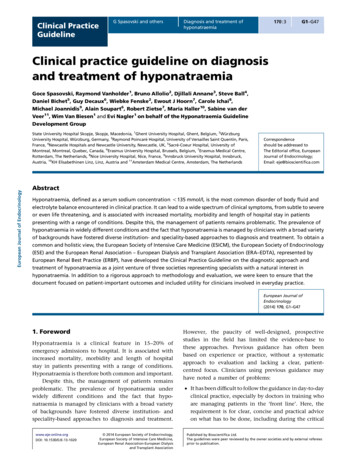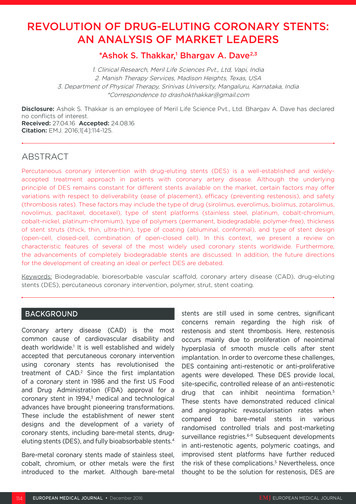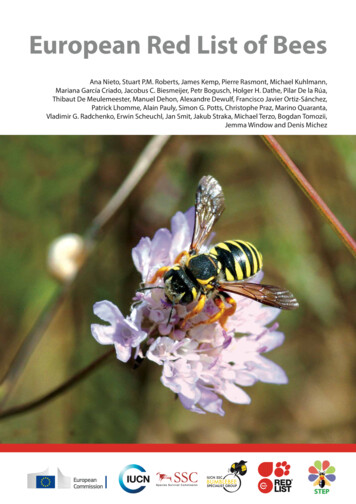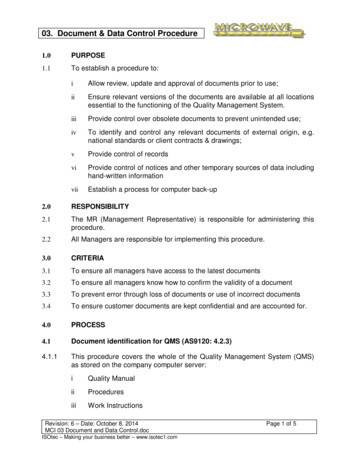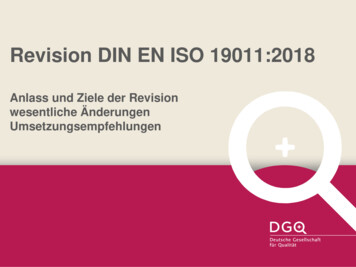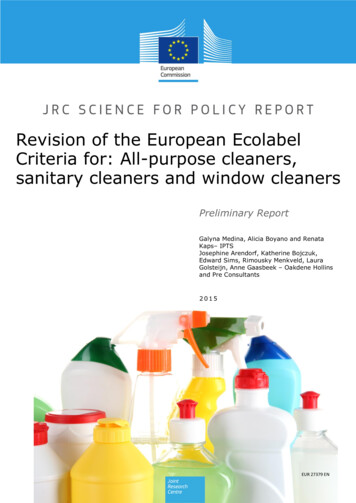
Transcription
Revision of the European EcolabelCriteria for: All-purpose cleaners,sanitary cleaners and window cleanersPreliminary ReportGalyna Medina, Alicia Boyano and RenataKaps– IPTSJosephine Arendorf, Katherine Bojczuk,Edward Sims, Rimousky Menkveld, LauraGolsteijn, Anne Gaasbeek – Oakdene Hollinsand Pre Consultants20151EUR 27379 EN
This publication is a Science for Policy report by the Joint Research Centre, the European Commission’s in-house science service. It aims toprovide evidence-based scientific support to the European policy-making process.The scientific output expressed does not imply a policy position of the European Commission. Neither the European Commission nor anyperson acting on behalf of the Commission is responsible for the use which might be made of this publication.JRC Science Hubhttps://ec.europa.eu/jrcJRC96849EUR 27379 ENPDFISBN 978-92-79-50315-3ISSN 1831-9424doi:10.2791/923LF-NA-27379-EN-N European Union, 2015Reproduction is authorised provided the source is acknowledged.How to cite: G. Medina, A. Boyano, R. Kaps, J. Arendorf, K. Bojczuk, E. Sims, r. Menkveld, L. golsteijn, A. Gaasbeek; Revision of the EuropeanEcolabel Criteria for: all-purpose cleaners, sanitary cleaners and window cleaners; EUR 27379 EN; doi: 10.2791/923All images European Union 2015, except: Cover image, Africa Studio, Fotolia.comAbstract:Towards a sustainable cleaning!The EU Ecolabel for All-purpose cleaners and sanitary cleaners is under revision. This report is meant to provide afirst evaluation of likely areas for investigation and provides the scientific evidence for the revised EU Ecolabelcriteria.The technical analysis found that the key environmental impacts of APCs are mainly due to the extraction stage,for window/glass cleaners packaging has larger contributions than ingredient extractions. When warm water isused to rinse off the product during use, the use phase has a significant impact. These findings are reflected inthe score of the environmental indicators under considerationBased on these findings, measures should be developed in close cooperation with stakeholders (industry,academia and interested parties) to improve the formulation of the cleaners, decrease the energy consumed toheat the water and decrease the amount of product used per application, among others.This preliminary report takes part of the revision of the EU Ecolabel criteria for six detergents and cleanersrelated product groups. The EU Ecolabel revision process is foreseen to be held simultaneously. The progress index.html2
Table of contentsExecutive summary . 61.2.INTRODUCTION . 81.1Background . 81.2Purpose of this document . 81.3EU Ecolabel for all-purposes cleaners and sanitary cleaners. 91.4Investigation overview . 9LEGAL REVIEW, SCOPE AND DEFINITION . 102.1Introduction . 102.2Scope and definition . 102.2.1 Product definition .102.2.2 Product composition .122.2.3 Current EU Ecolabel product scope and definition .122.3Feedback from stakeholder consultation . 132.3.1 Summary of the stakeholder's consultation and implications in therevision of the EU Ecolabel criteria. .242.4Review of legislation – key changes since the 2011 revision . 252.4.1 Regulation EC/66/2010 (the EU Ecolabel Regulation) .252.4.2 Regulation (EU) No 528/2012 (the Biocidal Product Regulation) .262.4.3 Regulation (EC) No 1272/2008 (The CLP Regulation) .262.4.4 Regulation (EU) No 259/2012 (the Detergents Regulation) .273.2.5Review of national ecolabels . 272.6Summary of the findings. 66MARKET ANALYSIS . 673.1Introduction . 673.1.1 Economic indicators .673.1.1.1 Trade and production data, cleaning products market .683.1.1.2 Data sources and split .723.2Market structure . 743.2.1 Global overview, market size .743.2.2 EU Overview, market size.753.2.3 EU market structure, national level .763.2.4 Market segmentation .773.2.5 All-purpose cleaners .793.2.6 Window/glass cleaners .803.2.7 Sanitary cleaners .803
3.2.8 Manufacturers and market share .833.2.9 Brand data .833.2.10 Supply chain and raw materials .853.3Trends and innovation . 873.3.1 Market trends .873.3.2 Environmental sustainable cleaning products .893.3.3 Consumer trends and market innovations .963.44.Conclusions . 98TECHNICAL ANALYSIS . 1004.1Technological aspects . 1004.1.1 Supply chain for APC production . 1004.1.2 Description of the production process . 1014.1.3 Ingredients. 1014.2LCA screening: number of studies and methodology . 1024.2.1 Selection criteria . 1024.2.2 Selection of reports . 1034.2.3 Detailed revision of selected reports . 1074.3LCA screening: results . 1104.3.1 Results of the selected studies . 1104.3.2 Summary of findings . 1124.4Non-LCA impacts . 1134.4.1 Toxicity to aquatic organisms . 1134.4.2 Risk assessment of chemical release . 1154.4.3 Sustainable sourcing. 1154.5In-house LCA studies . 1164.5.1 Methodology . 1164.5.2 Life cycle inventory . 1184.6Sensitivity analysis . 1254.6.1 Product formulation . 1254.6.2 Surfactant origin . 1274.6.3 Product dosage . 1285.4.7Comparison to other APC products . 1334.8Summary of findings . 134PRODUCT INNOVATIONS AND IMPROVEMENT POTENTIAL . 1365.1Introduction and approach . 1365.2APC product innovations . 1365.2.1 Formulation optimisation . 1365.2.2 Compaction of detergents . 1374
5.2.3 Natural/renewable ingredients . 1375.3Conclusions . 1376.CONCLUSIONS AND FURTHER STEPS . 1417.References . 1428.List of abbreviations and definitions . 1439.List of figures . 14610.List of tables . 147ANNEXES . 149Annex I: All-purpose and sanitary cleaner ingredients . 149Annex II: Stakeholder survey . 152Annex III: Life cycle impact assessment . 166Annex IV: Contribution analysis of different life cycle stages . 167Annex V: Sensitivity analysis. 169Annex VI Responses to the stakeholder questionnaire . 1765
Executive summaryThe Preliminary Report presents the research carried out on areas related to the productgroups covered by the EU Ecolabel on all-purpose cleaners and sanitary cleaners. Thereport provides background information that underpins to the new criteria proposals.Policy contextThe EU Sustainable Consumption and Production and Sustainable Industrial Policy(SCP/SIP) policy is an integral part of the Resource Efficiency flagship initiative of theEurope 2020 Strategy. This policy aims to reduce the environmental impact of productionand consumption and contribute to the decoupling of the economic growth fromenvironmental degradation.The EU Ecolabel is the main instrument included in this Plan aiming at promotingproducts with the best environmental performance. The EU Ecolabel is a voluntary toolawarded to a product through a process in which an applicant has to demonstrate thatthe specified Ecolabel criteria for a particular product group are met. The criteria theproducts must meet are being developed based on a life-cycle assessment of the mostimportant environmental impacts on a product group basis.This study is being carried out by the Joint Research Centre's Institute for ProspectiveTechnological Studies (JRC-IPTS) together with Oakdene Hollins and Pre-consultants. Thework is being developed for the European Commission's Directorate General for theEnvironment. The report will be used as a consultation document to gain feedback,evidence and opinion from stakeholders and experts on the proposed changes andsignificant environmental issues.Key conclusionsThis background document for the revision of the criteria for EU Ecolabel for all-purposecleaners and sanitary cleaners (both kinds of products will be referred to collectively asAPC in this study) is meant to provide a first evaluation of likely areas for investigation asa result of stakeholder surveys, market analysis and known concerns with existingcriteria, including changes in hazardous substance classification of commonly usedingredients. As policy-relevant recommendations, it points out where there is scope forstrengthening the EU Ecolabel and which criteria could be removed, amended or furtherdeveloped.The information contained in this document provides an overview of changes to the allpurpose and sanitary cleaners market since the last revision of the criteria in 2011, and atechnical analysis to understand where the greatest environmental impacts arise in theirlife cycle.Main findingsThe main findings of the Preliminary Report are:-The market analysis reported that the total retail value of the EU market for hardsurface cleaning is 5,7 bn. The cleaning market across Europe can be furthercategorised as all-purpose cleaners (46%), window/glass cleaners (4%), sanitarycleaning (36%) and other ancillary cleaning products (14%). Consumer choice ofcleaning products is driven by ease of use and convenience of the product, price,health and safety during use and efficacy of the product.-The technical analysis found that the key environmental impacts of APCs aremainly due to the extraction stage. For window/glass cleaners packaging has alarger contribution than ingredient extraction. When warm water is used to rinseoff the product during use, the use phase has a significant impact. However, thisis only relevant for some of the products covered by this product group, such askitchen cleaners and all-purpose cleaners.6
- Based on the normalisation chosen by far the most important impact categoryfor all-purpose cleaners in Europe is natural land transformationThe results of the LCA for a general purpose cleaner showed that ingredient extraction isan important contributor to the characterised midpoint results, particularly for theterrestrial ecotoxicity, agricultural land occupation and natural land transformationimpact categories. Of all the ingoing substances, the majority of the environmentalimpact can be attributed to ethoxylated alcohol surfactants. The manufacturing, use anddisposal phases also represent important contributors to the overall environmentalimpact.The KPIs based on the results of this study, are (not ranked):- Amount of product used per application,- Formulation – specifically the choice and amount of surfactant,- Energy consumed to heat the water (if warm water is used),- Energy source used to heat the water (if warm water is used).Moreover, even though waste generation was not among the top 4 KPIs namedpreviously, it can still have an impact of up to 37% for some environmental aspects. Thisenvironmental impact score can even being higher in the case of window cleaners. Giventhe prevalence of cleaners in everyday life and the fact that they all come withpackaging, a relatively small impact can quickly add up; thus, this aspect is alsoconsidered in the EU Ecolabel.Figure 1: Impact contribution of different life cycle stages of an all-purpose cleaner according to the ILCDmethodRelated and future JRC workThis preliminary report takes part of the revision for EU Ecolabel criteria for six detergentproduct groups, namely: "Detergents for dishwasher", "Industrial and institutionalautomatic dishwasher detergents", "Laundry detergents", "Industrial and institutionallaundry detergents", "All purpose cleaners and sanitary cleaners" and "Hand dishwashingdetergents". The publication of this report is foreseen to be followed by continuous wideconsultation with experts and stakeholders, i.e. manufacturers, supply chain industry,consumer organizations and NGOs. The progress of these discussions can be followedthrough the official website tml.7
1. INTRODUCTION1.1 BackgroundThe EU Sustainable Consumption and Production and Sustainable Industrial Policy(SCP/SIP) policy is an integral part of the Resource Efficiency flagship initiative of theEurope 2020 Strategy1. This policy aims to reduce the environmental impact ofproduction and consumption and contribute to the decoupling of the economic growthfrom environmental degradation. The objective of the 'product pillar' of this policy is toimprove the environmental performance of products on the EU market through a mix ofsupply and demand side measures.The European Sustainable Consumption and Production and Sustainable Industrial PolicyAction Plan2 adopted in 2008 outlined the dynamic system of regulatory, market basedand voluntary information instruments that removes the worst products from the marketand stimulates production and consumption of better products. The EU Ecolabel 3 is themain instrument included in this Plan aiming at promoting products with the bestenvironmental performance.The EU Ecolabel is a voluntary tool awarded to a product through a process in which anapplicant has to demonstrate that the specified Ecolabel criteria for a particular productgroup are met. The criteria the products must meet are being developed based on a lifecycle assessment of the most important environmental impacts on a product group basis.The successful applicant is then allowed to use the EU Ecolabel logo and advertise theproduct as having been awarded the EU Ecolabel.1.2 Purpose of this documentThis background document for the revision of the criteria for EU Ecolabel for all-purposecleaners and sanitary cleaners (both kinds of products will be referred to collectively asAPC in this study) is meant to provide you with a first evaluation of likely areas forinvestigation as a result of stakeholder surveys, market analysis and known concernswith existing criteria, including changes in hazardous substance classification ofcommonly used ingredients. It identifies where there is scope for strengthening the EUEcolabel and which criteria could be removed, amended or further developed.The information contained in this document provides an overview of changes to the allpurpose and sanitary cleaners market since the last revision of the criteria in 2011, and atechnical analysis to understand where the greatest environmental impacts arise in theirlife cycle.This report is also being used as a consultation document to gain feedback, evidence andopinion from stakeholders and experts on the proposed changes and significantenvironmental issues.1COM(2010)2020COM(2008)3973Regulation (EC) No 66/2010 of the European Parliament and the Council of 25 November 2009 on the EU Ecolabel, 30.1.2010 OJEU L27/1available at: uri OJ:L:2010:027:0001:0019:en:PDF28
1.3 EU Ecolabel for all-purposes cleaners and sanitary cleanersThe EU Ecolabel criteria for ‘all-purpose cleaners and sanitary cleaners’ were adopted inEU Commission Decision 2011/383/EU. The aim of these criteria was to promote allpurpose cleaners and sanitary cleaners that correspond to the top 10-20% environmentalperforming of the products available on the Community considering the whole life cycle ofproduction, use and disposal. These criteria are due to expire in 2016. A breakdown ofthe number of EU Ecolabel products for the APC category can be found in the marketanalysis.1.4 Investigation overviewThe revision process takes the existing criteria document as the starting point and seeksto update these, taking into account technological and economic changes in the Europeanmarket, relevant legislative change and improved scientific knowledge.To review the existing EU Ecolabel criteria, the following aspects have been investigated:1) Product definition and categorisation.2) Economic and market analysis.3) Technical analysis including environmental performance investigation.4) Product innovations and improvement opportunities for dishwasher detergents.9
2. LEGAL REVIEW, SCOPE AND DEFINITION2.1 IntroductionThe aim of the first task is to conduct a review of the practicality of the existing productgroup definition and scope. The areas where the existing criteria and scope are nolonger in line with current legislation or alternative voluntary labelling schemes will beidentified. The review will consider feedback from stakeholders, literature reviews, legalreviews and alternative ecolabels. This first task has been divided into the following subtasks:1.2.3.4.5.An introduction to the existing product scope and definition.A summary of the feedback received from the stakeholder questionnaire.A review of existing EU legislation that is likely to affect the criteria revision.A review of alternative and national ecolabels for all-purpose and sanitary cleaners.The proposed scope and definitions for the all-purpose-cleaners and sanitarycleaners category (abbreviated as APC in this document).2.2 Scope and definition2.2.1 Product definitionBefore investigating the classification and definition of all-purpose and sanitary cleaners(APCs), it is important that key concepts of the product, such as its composition, are fullydescribed and understood. Within the context of the EU Ecolabel and this report, thedefinition used for detergents is taken from the definition of detergents used in theRegulation (EC) No 648/2004 (the Detergents Regulation).4‘Detergent’ means any substance or mixture containing soaps and/or othersurfactants intended for washing and cleaning processes. Detergents may be inany form (liquid, powder, paste, bar, cake, moulded piece, shape, etc.) andmarketed for or used in household, or institutional or industrial purposes.The Detergents Regulation defines ‘cleaning preparation’ as the following:‘Cleaning preparation’, intended for domestic all purposes cleaners and/or othercleaning of surfaces (e.g.: materials, products, machinery, mechanical appliances,means of transport and associated equipment, instruments, apparatus, etc.)In addition to the definition provided by the Detergent Regulation, it is beneficial toinclude definitions of products which fall under the EU Ecolabel APC category, from othersources. This section provides definitions which may be useful for further understandingthe APC product category. A search on definitions of all-purpose and sanitary cleanersfound the definition provided by Public Health and the Environment (RIVM) to be themost complete. The Dutch National Institute for RIVM in its fact sheet on cleaningproducts defines all-purpose cleaners intended for household use as the following5:'All-purpose cleaners' can be used for cleaning hard surfaces like windows,mirrors, wood, floors and tiled walls. They are used for different purposes in andaround the house. Because the types of soil and the sorts of surfaces differ, there4EC Regulation 648/2004 of The European Parliament and of The Council of 31 March 2004 on detergents. Available als/documents/specific-chemicals/detergents/index en.htm5Cleaning Products Fact Sheet To assess the risks for the consumer, RIVM report 320104003/2006.10
are all kinds of all-purpose cleaners: regular, concentrated, liquid soft soap andacid cleaners; the last can remove scale. There is no universal cleaner inparticular that can handle all cleaning objectives and their soil. All-purposecleaners are offered as liquids, they are also available as trigger sprays or astissues.The on-going studies for the development of European Green Public Procurement criteriafor cleaning services provide a definition for ‘professional cleaning operations’:'Professional cleaning operations' performed regularly or periodically in order tokeep an indoor space clean and sanitized, and that can be performed manually ormaking use of machinery.For sanitary cleaners, few definitions of this product group have been found. We havechosen to use the definition from the Good Environmental Choice Australia Standard:'Sanitary cleaners': includes cleaners for use on toilets, bathrooms and other wetareas.However, other definitions that fall into the sanitary cleaners’ classification referspecifically to one or several sub-products included into this group. This is the case of thedefinitions provided by Nordic Ecolabelling for the following products:'Ready-to-use WC professional' are professional toilet cleaners that are pre-dilutedand ready for use straight from the package. This category only includes productsfor use on toilets and excludes cleaners for other sanitary porcelain and bathroomcleaners'Ready-to-use window cleaner, consumer and professional' are professionalwindow and glass cleaners that are pre-diluted and ready for use straight from thepackage.'Ready-to-use WC consumer' are consumer toilet cleaners that are pre-diluted andready for use straight from the package. This category only includes products foruse on toilets and excludes cleaners for other sanitary porcelain and bathroomcleaners.For window cleaners, the definition provided by New Zealand’s Good EnvironmentalChoice scheme has been chosen:Glass and window cleaner means a product designed to clean glass or other highlypolished surfaces, including window, mirrors and metallic surfaces.Within the product groups ‘all-purpose cleaners’ and ‘sanitary cleaners’, there are subcategories for products which cover different cleaning functions. In the first instance it isuseful to define these different products that fit under the subcategories of all-purposecleaners, sanitary cleaners and window cleaners. Table 1 provides definitions for theseproducts.Table 1: Cleaning products which fall under the categories all-purpose cleaners and sanitary cleaners6Product use DefinitionExamplescategoryGeneralGeneral or multi-purpose cleaners are intended for use in a variety Multi-purpose trigger(multi)of applications indoors and primarily intended for cleaning of hardspray, concentrated floorpurposesurfaces. They can be formulated for professional or domestic use, cleaner, multi-purposeready to use or require dilution prior to use.concentrated cleanerBathroomA product used to clean hard surfaces in a bathroom, such asLimescale removers,6Not appearing in the current EU Ecolabel criteria for All-purpose cleaners and sanitary cleaners. These are general definitions have beenadded aiming at clarifying the names of stated in product use category column.11
cleanersScouringcleanersGlasscleanersToilet bowlcleanersKitchencleanercounters, walls, floors, fixtures, basins, bath tubs and tiles. Thisdoes not include products specifically intended to clean toilet7bowls.Surface cleaners combining an abrasive.bathroom cleaner triggerspray, other ready to usebathroom cleanersAbrasive kitchen liquidsCleaners specifically formulated for the cleaning of glass.Glass cleaner triggersprayAcidic toilet cleaner readyto useProducts designed specifically to clean the toilet bowl and whichhave no other intended use. Toilet cleaners are divided into twodifferent sub categories: acidic and bleach containing.Cleaners designed for use on kitchen surfaces such as work tops,cookers, tiles and wash basins.Kitchen surface cleanertrigger spray2.2.2 Product compositionThe key active components of the formulation of APCs are: surfactants, builders,bleaching agents, acids and scouring abrasives. In addition to these, secondarycomponents including solvents, biocides, fragrances, dyes, preservatives, thickeningagents and water are added to formulations. A description of each of these ingredients isprovided in Annex I.While the function of APCs us to remove stains, their chemical compositions varydepending on their exact function. For instance scouring agents contain abrasives toenhance their cleaning effect. Kitchen cleaners contain more surfactants than other typesof cleaner (5-30% of the formulation) and more alkalis (1-35%), this is necessary forremoving different kinds of soil and grease.5 Window cleaners contain fewer ingredientsthan other types of APC, typical formulations contain little more than surfactants, alcohol,fragrance and water.Sanitary cleaners often contain strong acids, because they need to be able to removemineral deposits as well as normal organic and inorganic soils from sinks, toilets andother sanitary ware. Toilet cleaners are divided into two different product typesdepending on their formulation. They can be either acid-containing for removal of calciumor metal salts, or they can be bleach-containing. For comparison the standardformulations of different types of APCs are provided in Annex I.2.2.3 Current EU Ecolabel product scope and definitionThe Commission Decision 2011/383/EU8 defines ‘all-purpose cleaners and sanitarycleaners’ as the following:The product group ‘All-purpose cleaners and sanitary cleaners’ shall comprise: allpurpose cleaners, window cleaners and sanitary cleaners.a) All-purpose cleaners comprising detergent products intended for the routingcleaning of walls, ceilings, windows and other fixed surfaces, and which are eitherdiluted in water prior to use or used without dilution. All-purpose cleaners shallmean products intended for indoor use in buildings which include domestic,commercial and industrial facilities.7Definition adapted from Green Seal Standard for Cleaning Products for Household Use, edition 5.1, July 2013.Commission Decision of 28 June 2011 on establish
categorised as all-purpose cleaners (46%), window/glass cleaners (4%), sanitary cleaning (36%) and other ancillary cleaning products (14%). Consumer choice of cleaning products is driven by ease o


